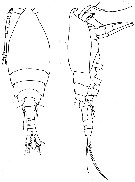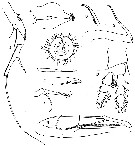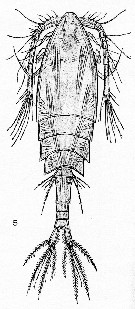|
|
 |
Fiche d'espèce de Copépode |
|
|
Siphonostomatoida ( Ordre ) |
|
|
|
Megapontiidae ( Famille ) |
|
|
|
Hyalopontius ( Genre ) |
|
|
| |
Hyalopontius typicus Sars, 1909 (F,M) | |
| | | | | | | Syn.: | Megapontius gigas Hulsemann, 1965 (p.45, Descr.F, figs.F) | | | | Ref.: | | | Sars, 1909 (p.6, Descr.F, figs.F); Sars, 1938 (p.38, Fig.F); Boxshall, 1979 (p.244, figs.F,M); Huys & Boxshall, 1991 (p.266, 443, figs.); Boxshall & Halsey, 2004 (p.786: figs.F); Vives & Shmeleva, 2010 (p.400, figs.F,M, Rem.); Laakmann & al., 2019 (p.330, fig. 2, 3, phylogenetic relationships) |  issued from : K. Hulsemann in Crustaceana, 1965, 9 (1). [p.46, Figs.1-2]. As Megapontius gigas. Female (from off E Azores): 1-2, habitus (dorsal and lateral, respectively). Nota: Proportional lengths of cephalosome: metasome: urosome are 45:17:38. Posterior lateral corners of the 2nd and 3rd metasomal segments are produced into a point. Genital segment exceeds the combined lengths of the succeeding two urosomal segments; the anterior end of the genital segment is expanded at the point where the lateral setae emerge. Caudal rami slightly divergent. A1 11-segmented
|
 issued from : K. Hulsemann in Crustaceana, 1965, 9 (1). [p.47, Figs.3-12]. As Megapontius gigas. Female: 3, A2; 4, oral cone; 5, ventral view at tip of oral cone (stage III copepodid); 6, Md; 7, tip of Md; 8, Mx1; 9, Mx2; 10, tip of Mx2; 11, Mxp; 12, P1. Nota: A2 biramous; endopod 2-segmented; a rudimentary 1-segmented exopod bearing 3 setae; there are patches of fine hairs on the anterior side of the proximal segment of the endopod; a row of fine, short hair is present along the entire length of the posterior side of the exopodal apical segment. Emerging from the end of the oral cone (fig.4) is a tube with a trumpet-like opening which is incompletely closed on the anterior side (fig.5); the periphery of the tube bears slender, sac-like appendages. Md without palpus; the slender mandible blade penetrates the cone up to its apical end in such a way that the serrated tips of both blades can be seen from the ventral side. The inner lobe of Mx1 is larger than the outer lobe and bears 3 parallel terminal setae which are recurved and divergent at their tips; 1 strong and 1 very small terminal setae arise from the outer lobe.Mx2 2-segmented. mxp 3-segmented (segments 1 and 2 incompletely separated).
|
 issued from : K. Hulsemann in Crustaceana, 1965, 9 (1). [p.48, Figs.13-16]. As Megapontius gigas. Female: 13, P2; 14, P3; 15, P4; 16, P5. (ventral side). Nota: P5 very small, 2-segmented; the proximal segment is imperfectly separated from the 1st segment of the urosome, it bears 1 lateral seta; the distal segment with 2 short outer and 1 fairly long terminal setae.
|
 issued from : G.A. Boxshall in Bull. Br. Mus. nat. Hist. (Zool.), 1979, 35 (3). [p.245, Fig.19]. Female (from NE Atlantic: 44°N, 12°W): A, habitus (dorsal); B, anterior portion of urosome (left lateral side); C, A1; D, A2; E, P5. Male: F, urosome (ventral); G, caudal ramus; H, Mxp; I, P5; J, P6.
|
 issued from : G.O. Sars in Res. Camp. Scient. Prince Albert Ier Movaco, 1938 (97). [Pl. I, Fig.5]. Female (from 31°-37°N, 19°-28°W): 5, habitus (dorsal).
| | | | | Ref. compl.: | | | Sirenko & al., 1996 (p.349); Kosobokova & Hirche, 2000 (p.2029, tab.2); Kosobokova & Hopcroft, 2010 (p.96, Table 1, fig.7); Bucklin & al., 2010 (p.40, Table 1, Biol mol.); Kosobokova & al., 2011 (p.29, Table 2, fig.4, Rem.: Arctic Basins) | | | | NZ: | 2 | | |
|
Carte de distribution de Hyalopontius typicus par zones géographiques
|
| | | | Loc: | | | NW off Cape Finisterre , off Azores (E, W & S), Arct. (Laptev Sea, Lomonosov Ridge, Nansen Basin, Amundsen Basin, Makarov Basin, Canada Basin) | | | | N: | 9 | | | | Lg.: | | | (138) F: 5,3-4,87; M: 5,05-4,6; (715) F: 5,26; {F: 4,87-5,30; M: 4,60-5,05} | | | | Rem.: | bathypélagique.
Caractéristiques morphologiques female: Angles du 3ème segment pedigère pratiquement symétrique. Bords postérieurs dorsaux des segments de l'urosome lisses, sans membrane festonée. | | | Dernière mise à jour : 02/04/2019 | |
|
|
 Toute utilisation de ce site pour une publication sera mentionnée avec la référence suivante : Toute utilisation de ce site pour une publication sera mentionnée avec la référence suivante :
Razouls C., Desreumaux N., Kouwenberg J. et de Bovée F., 2005-2025. - Biodiversité des Copépodes planctoniques marins (morphologie, répartition géographique et données biologiques). Sorbonne Université, CNRS. Disponible sur http://copepodes.obs-banyuls.fr [Accédé le 04 juin 2025] © copyright 2005-2025 Sorbonne Université, CNRS
|
|
 |
 |








